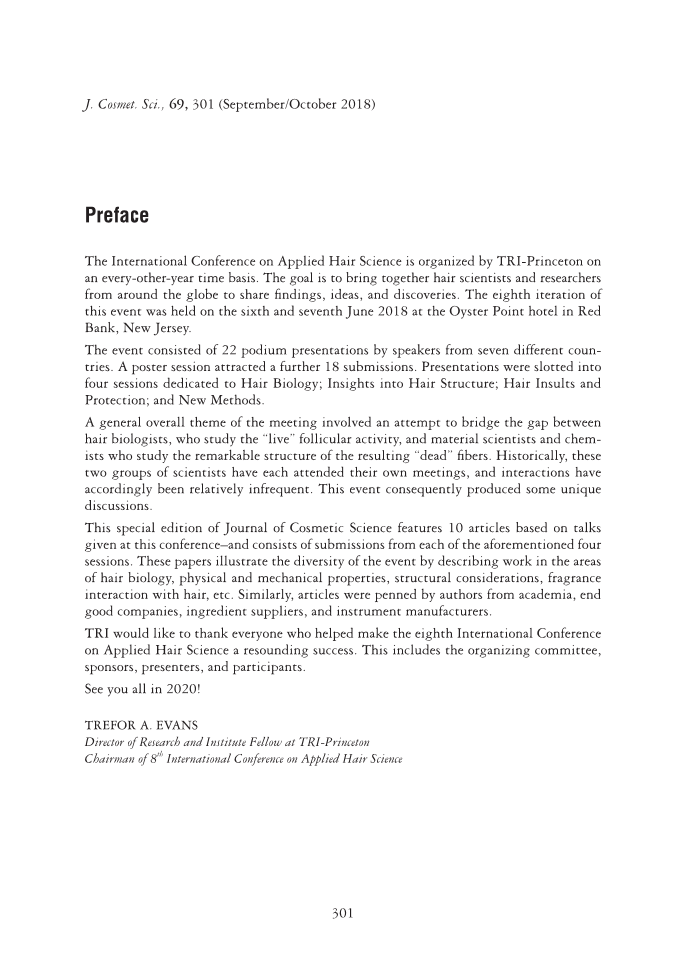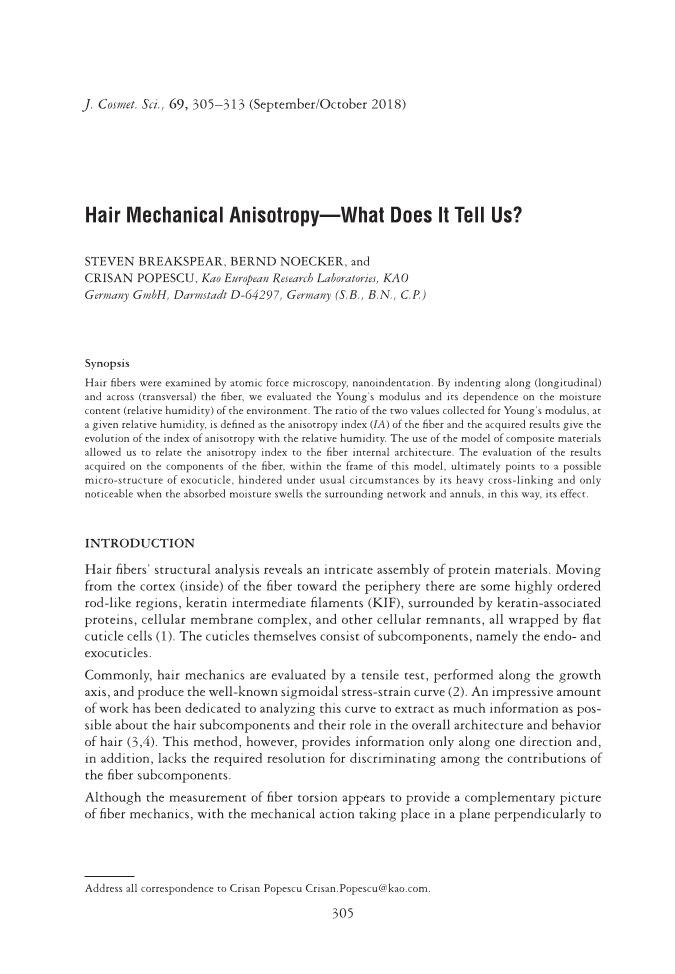J. Cosmet. Sci., 69, 301 (September/October 2018) 301 Preface The International Conference on Applied Hair Science is organized by TRI-Princeton on an every-other-year time basis. The goal is to bring together hair scientists and researchers from around the globe to share fi ndings, ideas, and discoveries. The eighth iteration of this event was held on the sixth and seventh June 2018 at the Oyster Point hotel in Red Bank, New Jersey. The event consisted of 22 podium presentations by speakers from seven different coun- tries. A poster session attracted a further 18 submissions. Presentations were slotted into four sessions dedicated to Hair Biology Insights into Hair Structure Hair Insults and Protection and New Methods. A general overall theme of the meeting involved an attempt to bridge the gap between hair biologists, who study the “live” follicular activity, and material scientists and chem- ists who study the remarkable structure of the resulting “dead” fi bers. Historically, these two groups of scientists have each attended their own meetings, and interactions have accordingly been relatively infrequent. This event consequently produced some unique discussions. This special edition of Journal of Cosmetic Science features 10 articles based on talks given at this conference–and consists of submissions from each of the aforementioned four sessions. These papers illustrate the diversity of the event by describing work in the areas of hair biology, physical and mechanical properties, structural considerations, fragrance interaction with hair, etc. Similarly, articles were penned by authors from academia, end good companies, ingredient suppliers, and instrument manufacturers. TRI would like to thank everyone who helped make the eighth International Conference on Applied Hair Science a resounding success. This includes the organizing committee, sponsors, presenters, and participants. See you all in 2020! TREFOR A. EVANS Director of Research and Institute Fellow at TRI-Princeton Chairman of 8th International Conference on Applied Hair Science
J. Cosmet. Sci., 69, 305–313 (September/October 2018) 305 Hair Mechanical Anisotropy—What Does It Tell Us? STEVEN BREAKSPEAR, BERND NOECKER, and CRISAN POPESCU, Kao European Research Laboratories, KAO Germany GmbH, Darmstadt D-64297, Germany (S.B., B.N., C.P.) Synopsis Hair fi bers were examined by atomic force microscopy, nanoindentation. By indenting along (longitudinal) and across (transversal) the fi ber, we evaluated the Young’s modulus and its dependence on the moisture content (relative humidity) of the environment. The ratio of the two values collected for Young’s modulus, at a given relative humidity, is defi ned as the anisotropy index (IA) of the fi ber and the acquired results give the evolution of the index of anisotropy with the relative humidity. The use of the model of composite materials allowed us to relate the anisotropy index to the fi ber internal architecture. The evaluation of the results acquired on the components of the fi ber, within the frame of this model, ultimately points to a possible micro-structure of exocuticle, hindered under usual circumstances by its heavy cross-linking and only noticeable when the absorbed moisture swells the surrounding network and annuls, in this way, its effect. INTRODUCTION Hair fi bers’ structural analysis reveals an intricate assembly of protein materials. Moving from the cortex (inside) of the fi ber toward the periphery there are some highly ordered rod-like regions, keratin intermediate fi laments (KIF), surrounded by keratin-associated proteins, cellular membrane complex, and other cellular remnants, all wrapped by fl at cuticle cells (1). The cuticles themselves consist of subcomponents, namely the endo- and exocuticles. Commonly, hair mechanics are evaluated by a tensile test, performed along the growth axis, and produce the well-known sigmoidal stress-strain curve (2). An impressive amount of work has been dedicated to analyzing this curve to extract as much information as pos- sible about the hair subcomponents and their role in the overall architecture and behavior of hair (3,4). This method, however, provides information only along one direction and, in addition, lacks the required resolution for discriminating among the contributions of the fi ber subcomponents. Although the measurement of fi ber torsion appears to provide a complementary picture of fi ber mechanics, with the mechanical action taking place in a plane perpendicularly to Address all correspondence to Crisan Popescu Crisan.Popescu@kao.com.
Purchased for the exclusive use of nofirst nolast (unknown) From: SCC Media Library & Resource Center (library.scconline.org)









































































































